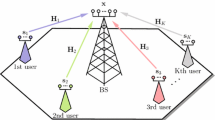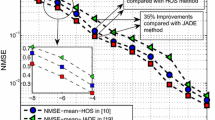Abstract
Reduced computational intricacy is needed to improve systems of wireless communication, like large multiple-input multiple-output (MIMO) systems. Large MIMO systems have demonstrated to operate at nearly optimal efficiency through linear minimum mean-square error (MMSE) detection. But the large-scale matrix inversion produces undue intricacy. Further, several detection methods such as variants of Jacobi, Richardson, Gauss–Seidel (GS), successive overrelaxation (SOR) and symmetric successive overrelaxation (SSOR) have garnered a lot of attention than traditional Neumann series expansion-based ones because they do not require matrix inversion. But for hardware design purposes, the intricacy remains too high. The goal of this paper is to meet the current demand for large MIMO communication systems by proposing a high data rate, low-intricacy hardware implementation technique for the transmission and detection of quasi-orthogonal space–time block codes (QOSTBC). A better option for less computational intricacy in large MIMO than QOSTBC may be the already-existing space–time block coding (STBC) and orthogonal space–time block coding (OSTBC). However, when featuring more than two antennas, STBC schemes and OSTBC schemes for complex symbols are unable to reach a full transmission code rate. Therefore, an QOSTBC for large MIMO systems which provides significant data rate, diversity order and reduced decoding intricacy with symbol-wise decoding is achieved in the suggested scheme. The instantaneous received signal-to-noise ratio’s moment generating function is employed to determine a closed-form mathematical manifestation for the symbol error rate (SER), which helps to explain the performance.







Similar content being viewed by others
References
A.E. Larsson, O. Edfors, F. Tufvesson, T.N. Marzetta, Massive MIMO for next generation wireless systems. IEEE Commun. Mag. 52(2), 186–195 (2014)
E. Björnson, J. Hoydis, M. Kountouris, M. Debbah, Massive MIMO systems with non-ideal hardware: energy efficiency, estimation, and capacity limits. IEEE Trans. Inform. Theory. 60(11), 7112–7139 (2014)
V. Tarokh, H. Jafarkhani, A. Calderbank, Space-time block coding for wireless communications: performance results. IEEE J. Sel. Areas Commun. 17, 451–460 (1999)
V. Tarokh, H. Jafarkhani, A. Calderbank, Space-time block codes from orthogonal designs. IEEE Trans. Inf. Theory 45, 1456–1467 (1999)
S. Alamouti, A simple transmitter diversity technique for wireless communications. IEEE J. Sel. Areas Commun. 16(8), 1451–1458 (1998)
E. Biglieri, Y. Hong, E. Viterbo, On fast-decodable space-time block codes. IEEE Trans. Inf. Theory 55(2), 524–530 (2009)
E. Basar, U. Aygolu, High-rate full-diversity space-time block codes for three and four transmit antennas. IET Commun. 3(8), 1371–1378 (2009)
E. Basar, U. Aygolu, Full-rate full-diversity STBCs for three and four transmit antennas. Electron. Lett. 44(18), 1076–1077 (2008)
E. Basar, U. Aygolu, E. Panayirci, H. Vincent Poor, Space-time block coded spatial modulation. IEEE Trans. Commun. 59(3), 823–832 (2011)
H. Jafarkhani, A quasi orthogonal space-time block code. IEEE Trans. Commun. 49, 1–4 (2001)
O. Tirkkonen, A. Boariu, A. Hottinen, Minimal non-orthogonality rate one space-time block codes for 3+ Tx antennas, in IEEE International Symposium on Spread Spectrum Techniques and Applications (ISSSTA), vol. 2, New Jersey, USA, September 2000, pp. 429–432
C.B. Papadias, G.J. Foschini, Capacity-approaching space-time codes for systems employing four transmitter antennas. IEEE Trans. Inf. Theory 49, 726–733 (2003)
J.C. Belfiore, G. Rekaya, E. Viterbo, The golden code: A 2 x 2 full-rate space-time code with non-vanishing determinants. IEEE Trans. Inf. Theory 51(4), 1432–1436 (2005)
F. Oggier, G. Rekaya, J.C. Belfiore, E. Viterbo, Perfect space – time block codes. IEEE Trans. Inf. Theory 52(9), 3885–3902 (2006)
A. Lotfi-Rezaabad, S. Talebi, A. Chizari, Two quasi orthogonal space-time block codes with better performance and low intricacy decoder, in International Symposium on Communication Systems, Networks and Digital Signal Processing (CSNDSP), Prague, Czech Republic (2016)
E. Agrell, T. Eriksson, A. Vardy, K. Zeger, Closest point search in lattices. IEEE Trans. Inf. Theory 48(8), 2201–2214 (2002)
M.O. Damen, H.E. Gamal, G. Caire, On maximum-likelihood detection and the search for the closest lattice point. IEEE Trans. Inf. Theory 49(10), 2389–2402 (2003)
C. Thrampoulidis, W. Xu, B. Hassibi, Symbol error rate performance of box-relaxation decoders in massive MIMO. IEEE Trans. Signal Process. 66(13), 3377–3392 (2018)
E.G. Larsson, J. Jalden, Fixed-intricacy soft MIMO detection via partial marginalization. IEEE Trans. Signal Process. 56(8), 3397–3407 (2008)
Z. Guo, P. Nilsson, Algorithm and implementation of the K-best sphere decoding for MIMO detection. IEEE J. Sel. Areas Commun. 24(3), 491–503 (2006)
B. Yin, M. Wu, C. Studer, J.R. Cavallaro, C. Dick, Implementation trade-offs for linear detection in large scale MIMO systems, in Proceedings of IEEE Acoustics, Speech and Signal Processing (ICASSP) (2013), pp. 2679–2683
H.Q. Ngo, M. Matthaiou, T.Q. Duong, E.G. Larsson, Uplink performance analysis of multicell MU-SIMO systems with ZF receivers. IEEE Trans. Veh. Technol. 62(9), 4471–4483 (2013)
X. Gao, L. Dai, Y. Hu et al., Matrix inversion-less signal detection using SOR method for uplink large-scale MIMO systems, in Proceedings of IEEE Global Communications Conference (GLOBECOM) (2014), pp. 3291–3295
L. Dai, X. Gao, X. Su, S. Han, Z. Wang et al., Low intricacy soft-output signal detection based on Gauss–Seidel method for uplink multi-user large-scale MIMO systems. IEEE Trans. Veh. Technol. 64(10), 4839–4845 (2015)
A. Yu, C. Zhang, S. Zhang, X. You, Efficient SOR-based detection and architecture for large-scale MIMO uplink, in Proceedings of IEEE Asia-Pacific Conference on Circuits and Systems, October 2016, pp. 402–405
M.K. Arti, A space-time transmission scheme for large MIMO systems. IEEE Wireless Commun. Lett. 7(1), 62–65 (2018)
I.S. Gradshteyn, I.M. Ryzhik, Table of Integrals, Series, and Products, 6th edn. (Academic, San Diego, 2000)
M.R. McKay, A. Zanella, I.B. Collings, M. Chiani, Error probability and SINR analysis of optimum combining in Rician fading. IEEE Trans. Commun. 57(3), 676–687 (2009)
D. Poole, Linear Algebra: A Modern Introduction, 2nd edn. (Brooks/Cole, Belmont, 2006). (ISBN:0-534-99845-3)
M.P. Holmes, A.G. Gray, J. Charles Lee Isbell, Fast SVD for large-scale matrices. http://sysrun.haifa.il.ibm.com/hrl/bigml/files/Holmes.pdf. Accessed 13 July 2017
F. Jiang, C. Li, Z. Gong, A low intricacy soft-output data detection scheme based on Jacobi method for massive MIMO uplink transmission, in Proceedings of IEEE International Conference on Communications, May 2017, pp. 1–5
Funding
The authors have not disclosed any funding.
Author information
Authors and Affiliations
Corresponding author
Ethics declarations
Conflict of Interests
I, Shimpee Seema, on behalf of all authors declare that we have no known competing financial interests or personal relationships that could have appeared to influence the work reported in this paper.
Additional information
Publisher's Note
Springer Nature remains neutral with regard to jurisdictional claims in published maps and institutional affiliations.
Rights and permissions
Springer Nature or its licensor (e.g. a society or other partner) holds exclusive rights to this article under a publishing agreement with the author(s) or other rightsholder(s); author self-archiving of the accepted manuscript version of this article is solely governed by the terms of such publishing agreement and applicable law.
About this article
Cite this article
Seema, S., Arti, M.K. & Reddy, B.V.R. Large MIMO System Incorporating QOSTBC Transmission. J. Inst. Eng. India Ser. B (2024). https://doi.org/10.1007/s40031-024-01032-z
Received:
Accepted:
Published:
DOI: https://doi.org/10.1007/s40031-024-01032-z




